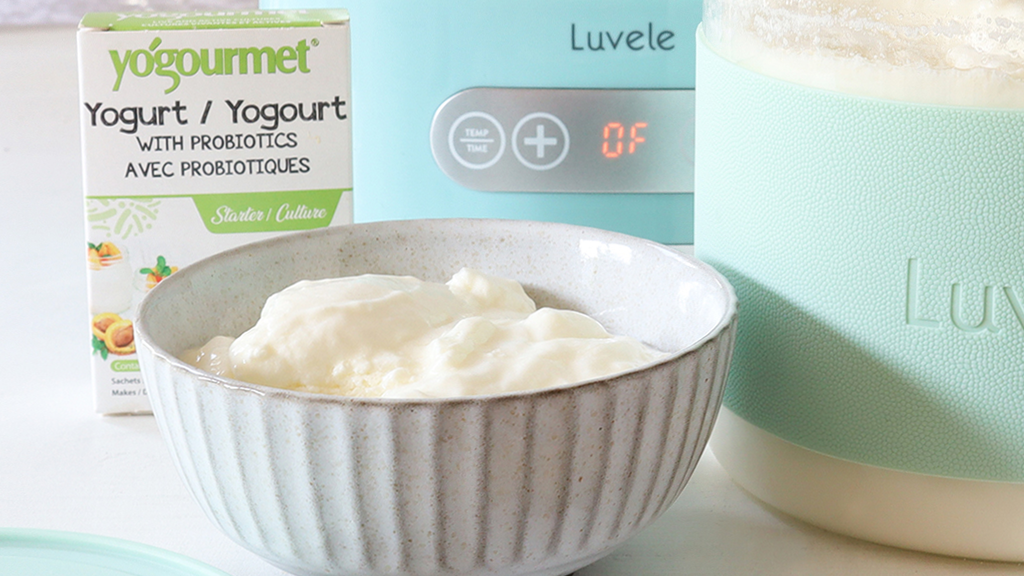Your Cart is Empty
Add description, images, menus and links to your mega menu
A column with no settings can be used as a spacer
Link to your collections, sales and even external links
Add up to five columns
Add description, images, menus and links to your mega menu
A column with no settings can be used as a spacer
Link to your collections, sales and even external links
Add up to five columns

How to make Yogourmet probiotic yogurt
Barb Hodgens
Barb Hodgens loves to cook with alternative, healthy whole food ingredients, with a focus on gut health. Barb has overcome her own gut health issues through healthy eating. Share your ideas, comments and photos at the end of this post :)

FOR IMMUNE SYSTEM & GUT HEALTH.
The probiotic content of yogurt depends on a few factors – most importantly, the quality and quantity of the starter culture used. The Yogourmet ‘Probiotic’ starter (green packet) has five strains of probiotic bacteria in easy to use, single-serve sachets, so it's a very convenient way to make delicious, gut loving, probiotic yogurt in the comfort of your own kitchen.
Yogourmet 'Probiotic' starter contains three traditional yogurt culture strains; L. bulgaricus, S. thermophilus, L. acidophilus (found in the Yogourmet 'Traditional' starter blend) plus two additional probiotic strains; Lactobacillus casei and Bifidobacterium (Bifidus) longum. L. casei to strengthen immune health and B. longum to promote regularity.

The temperature and time your yogurt is left to ferment matters too, but fortunately we have that covered for you. The digital timer and unique ‘water-bath’ technology in the Luvele range of yogurt makers make these two considerations failsafe. Yogourmet recommends between 9 and 15 hours. The Luvele test kitchen has sampled homemade probiotic yogurt at 9 hours, 15 hours and even 24 hours and can't decide which we prefer. We recommend you experiment at home to find your preferred sweet spot. (or should we say, tart spot!). Nine hours produces a thick and smooth creamy (milkier) yogurt but leaving it longer increases the acidity and flavour.

If you’re unsure which milk to use when you make Yogourmet probiotic yogurt, click over to our guide to choosing the best milk for making yogurt. For more great yogurt making recipes, tips and trouble shooting advice visit our yogurt basics page.

PREPARATION
Before you begin it is important to sterilise the Luvele yogurt making glass jar and any utensils you use, in boiling hot water. Do this by boiling a kettle and carefully pouring the hot water in the jar and over the equipment. The danger of not sterilising is that other bacteria may overpower your culture and affect the quality of your ferment.



How to make Yogourmet probiotic yogurt
Luvele
Rated 5.0 stars by 1 users
We believe homemade yogurt to be an essential food for good gut health. Not only does homemade yogurt taste better, it has guaranteed strains of beneficial that support the native good bacteria in your digestive system.
Ingredients
- 2 litres of milk
-
Yogourmet Probiotic Starter culture
Directions
- Pour the milk into a large, clean saucepan.
Heat and hold the milk at 82° C (180° F)
Use a thermometer. Note, as you become more confident with heating milk to make yogurt you will be able to judge when the milk is nearing 82° C (180° F) because it will begin to swell and rise in the pot (just before it simmers). Hold the heat at this temperature for anywhere between 2 - 10 minutes. The longer the better. Holding the milk at this high temperature allows the milk proteins to denature which thickens the yogurt. Tip: It can be a challenge to hold the milk at a high temperature for so long. Don’t get too caught up on the precise temperature. If the milk accidentally simmers briefly, don’t panic – reduce the heat and continue. Use a wok ring (or something similar) to create a distance between the flame and pot or use a double boiler pot filled with boiling water.Cover the milk & let cool to below 42° C (107° F)
It is fine if the milk cools down well below 42° or even goes cold, it just mustn't be too hot. Temperatures above 43° C will kill the starter culture. The perfect temperature range for making yogurt is between 36° C (97° F) and 42° C (107° F). Tip: You can actively cool it by filling a sink, or bowl with cold water and setting the pot of heated milk in the cold water.
As the milk cools a layer of skin will form on the yogurt. Some homemade yoghurt recipes recommend taking this off. There is no harm leaving it in though. It does not produce lumpy yoghurt. NOTE: If you are using unhomogenised milk, the skin will include the cream, which is divine. You don't want to miss out on this!- Pour the milk into the yogurt making jar.
Add the starter culture and gently whisk it in.
Tear open one 3 gram packet of Yogourmet Probiotic starter culture and pour it into the milk while whisking so that the grains of culture are evenly dispersed.- Place the glass yogurt jar into your yogurt maker.
Pour water slowly into the base.
The water must not be filled over the ‘tall line’ indicated on the inside wall of the maker.Place the cover lid on top.
The milk is now ready to begin fermentation.Set the time & temperature.
Use the digital control panel to set the temperature to 38° C (100° F), the time to between 9-24 hours and then press ‘confirm’ to begin incubation.When fermentation is complete.
Condensation will have collected under the cover lid. Please take care removing it and allow the water to drip into the water bath, instead of your bench!Switch the yogurt maker off and remove the yogurt jar.
Straight from the maker the yogurt will be runny and warm. Depending on the milk you used, there may be a layer of yellow cream on top of the yogurt.Place the jar in the fridge for at least 6 hours to chill and set.
Be gentle with the warm yogurt and don’t stir it or else it won’t
PIN THIS RECIPE

BUY YOUR STARTER CULTURE HERE

How to make Yogourmet probiotic yogurt

FOR IMMUNE SYSTEM & GUT HEALTH.
The probiotic content of yogurt depends on a few factors – most importantly, the quality and quantity of the starter culture used. The Yogourmet ‘Probiotic’ starter (green packet) has five strains of probiotic bacteria in easy to use, single-serve sachets, so it's a very convenient way to make delicious, gut loving, probiotic yogurt in the comfort of your own kitchen.
Yogourmet 'Probiotic' starter contains three traditional yogurt culture strains; L. bulgaricus, S. thermophilus, L. acidophilus (found in the Yogourmet 'Traditional' starter blend) plus two additional probiotic strains; Lactobacillus casei and Bifidobacterium (Bifidus) longum. L. casei to strengthen immune health and B. longum to promote regularity.

The temperature and time your yogurt is left to ferment matters too, but fortunately we have that covered for you. The digital timer and unique ‘water-bath’ technology in the Luvele range of yogurt makers make these two considerations failsafe. Yogourmet recommends between 9 and 15 hours. The Luvele test kitchen has sampled homemade probiotic yogurt at 9 hours, 15 hours and even 24 hours and can't decide which we prefer. We recommend you experiment at home to find your preferred sweet spot. (or should we say, tart spot!). Nine hours produces a thick and smooth creamy (milkier) yogurt but leaving it longer increases the acidity and flavour.

If you’re unsure which milk to use when you make Yogourmet probiotic yogurt, click over to our guide to choosing the best milk for making yogurt. For more great yogurt making recipes, tips and trouble shooting advice visit our yogurt basics page.

PREPARATION
Before you begin it is important to sterilise the Luvele yogurt making glass jar and any utensils you use, in boiling hot water. Do this by boiling a kettle and carefully pouring the hot water in the jar and over the equipment. The danger of not sterilising is that other bacteria may overpower your culture and affect the quality of your ferment.

 :recipekit:
:recipekit:PIN THIS RECIPE

BUY YOUR STARTER CULTURE HERE

Subscribe
Sign up to get weekly healthy recipes & information on new product releases.
Item is added to cart


